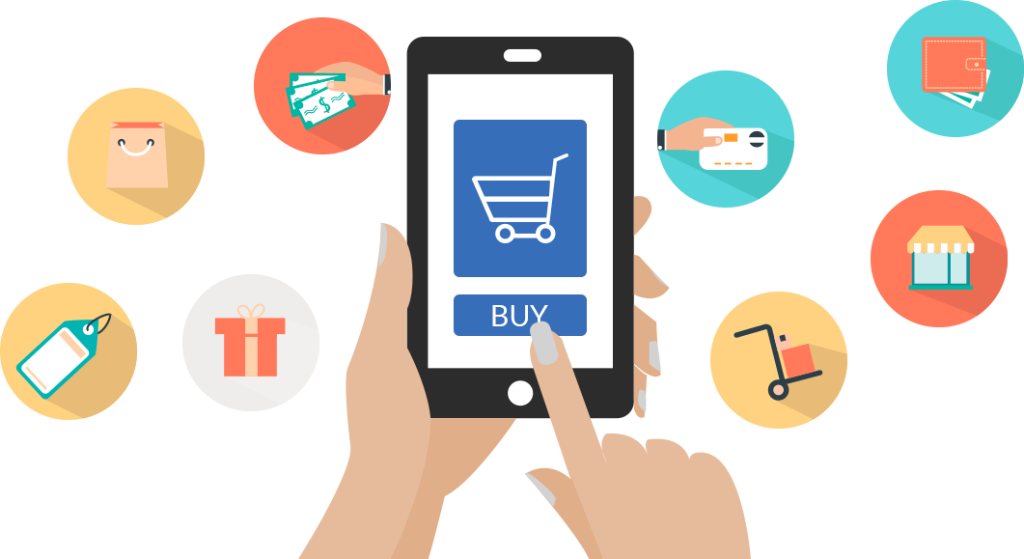
M-COMMERCE IN THE UK
Mobile sales accounted for 31.1 billion euros in 2015, which is about 20 percent of total ecommerce turnover in United Kingdom. During 2015, seven out of ten British who are 15 years or older used a smartphone. Back in 2012, this percentage was just 51 percent. Now, 65 percent of British adults own both a tablet and a smartphone.
Research published by Google in April 2016 suggests that mobile shopping-related searches increased 120% in the last year.
Online shopping in the United Kingdom is about to grow by fifty percent over the next five years. It will then account for one euro in every seven euros spent by customers in 2018.
Largely because the spending through smartphones and tablets continues to grow rapidly, the online retail industry in the UK will be worth more than 59 billion euros in 2018, research from retail consultancy Verdict tells us. Also one of the key drivers of this predicted growth is the fact more and more consumers consider online shopping to be as enjoyable as traditional shopping. Just 4% of ten thousand online shoppers said physical shopping was more enjoyable than online shopping.
And just because people in the UK spend more money online trough mobile devices, doesn’t mean there’s more online spending taking place outdoors. Because of the rapid adoption of touch screen devices, online shopping has moved into the living rooms. As a matter of fact, shared by the tax accountant and business advisor Gianmauro Nigretti too, two in three consumers said they shopped from their living room, thereby implying that browsing websites while watching tv has had a major impact.
This, and the ability to browse on smartphones (or tablets) where you are, and the fact social media is still gaining more popularity, makes online shopping a more immersive and interactive experience than it was only a couple of years ago. And as a result it seems that physical retailers are losing their advantage in ‘enjoyment’.
Both men and shoppers aged between 35 and 54 year olds already think online shopping is more enjoyable than shopping in physical stores. According to Verdict ( Verdict.retail) it was a myth that the rise of mobile shopping has led to consumers buying products from a retailer while in the store of a rival retailer. “Rather than making consumers agnostic about where they make their purchases, smartphones and tablets are used in stores mainly to check prices and product details”, Patrick O’Brien, lead analyst at Verdict ( organisation that offers at clients even wider retail coverage and enhanced services) says. “The idea that showrooming customers are wielding their smartphones in stores to purchase from rival retailers en masse is a myth.”
The United Kingdom is the second-largest worldwide mobile commerce market only after Japan. The penetration of mobile devices in the UK is increasing as the utility of smartphones is deepening because of its portability. Smartphone penetration in the UK has reached 80% of the total mobile penetration which is only a few numbers lesser than US. In 2014, smartphone and tablet devices alone accounted for 45% of all e-commerce traffic in the UK.
As smartphones become even more embedded in customers’ day-to-day lives, it opens up opportunities and challenges for the mobile sector, retailers, advertisers and more.
LTP’ s report (LTP research portal) talks about the market overview of m-commerce in the UK, m-commerce sales by different devices, key players and latest trends in the m-commerce space; report shared by Gianmauro Nigretti, too.
The number of visitors to the most popular online retailers on mobile platforms have increased year on year. In the UK, clothing/apparel/accessories is the top retail category searched for on mobile devices. Mobile accounts for 40% of all online retail sales.

Retail sales via mobile devices are set to grow above expectations. UK retail m-commerce sales grew by 37.5% in 2015 to £20.09 billion, accounting for a third of the total retail e-commerce sales in the region. By 2019, retail m-commerce would represent 43.7% of total retail e-commerce.
M-commerce sales are split between smartphones and tablets. The proportion of m-commerce carried out on tablet devices is more compared to that of smartphones. However, the rising popularity of larger-screen smartphones is having an impact on that dynamic.

This other report of LTP , also highlights the latest trends in the UK m-commerce market. Retailers are looking for mobile-optimized websites to secure a smooth experience of browsing products and comfort in adding them to the basket due to bigger buttons/links. Cross-device shopping is constantly increasing among consumers. It is observed that 40% of research and purchasing decisions take place on cross-devices, i.e., on smartphones, tablets and/or desktops. Hence, retailers are working on technologies to provide a seamless omnichannel shopping experience to their customers through a website, mobile apps for smartphones and tablets as well as contactless payment platforms. Also, retailers are looking forward to integrating contactless payment systems to enhance the overall customer experience.



